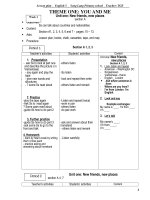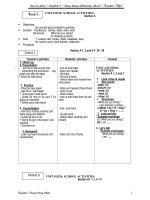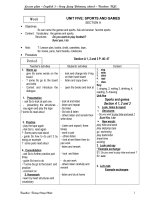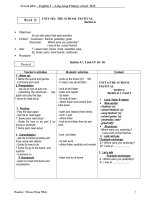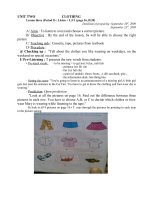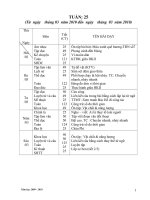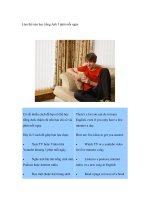GA ANH 5 CT MOI 20162017
Bạn đang xem bản rút gọn của tài liệu. Xem và tải ngay bản đầy đủ của tài liệu tại đây (144.52 KB, 15 trang )
<span class='text_page_counter'>(1)</span>Date of planing : 2/ 9/ 2016 Date of teaching: /9/2016. Week 1 Period 1 Unit 1: WHAT’S YOUR ADDRESS? Lesson 1: Part 1-2-3 I. Objectives: By the end of this unit pupils can - Use the words and phrases related to the topics addresses and hometown. Ask and answer questions about one’s address, using What’s your address? – It’s... - Develop Ss speaking and listening skills. - Ss look after , solve problems and study themselves. - Studious and obedient students and love their hometown, family and friends. II. Languages focus: - Sentence Pattners: What’s your address? – It’s... - Vocabulary: address, crowded, lane, quiet, tower, road. III. Teaching aids: 1. Teacher’s: student’s and teacher’s book, pictures, cassette. 2. Students’: books, notebooks, workbooks. IV. Teaching processes: 1. Class organization: - Greeting. Checking for the students' attendance. 2. Oral test: - Have pupils describe things in the room. 3. New lesson Teacher’s activities Students’ activities Warm up: Play slap the - The class play: using the pictures and names of board characters that they have learnt in Tieng Anh 3,4. 1. Look, listen and repeat. - Introduce the dialogue. - Look at the pictures in the book, identify the characters in the picture on page 30 and what they are saying. - Play the recording - Listen to Mai and Nam greeting. Nam introducing Mai to Trung. - Check and corect. - Ss listen and repeat in chorus two times. - Read in group/ pair: One repeats Mai’s part, the - Elicits the structure other repeats Nam’s part and Trung’ part. - Ss give new structure sentence: 2. Point and say - What’s your address? – It’s... - Teach vocabulary: - Note write down new words and read after T. Play game: What and where ( Whole class) Check vocab: what & where - Revise numbers 10 to 100 with the class. - Model sentence. - Pupils guess and complete the speech bubbles. - Monitor the activity and - Look and find out the model sentences offer help, if necessary. - Point the pictures and practise asking and answering question about one’s address. - Check and correct. - 2 - 3 pairs perform their task at the front of the class. The rest of the class observe and give 3. Let’s Talk comments. - Give tasks. - Ss work in pairs to practise asking and answering.
<span class='text_page_counter'>(2)</span> - Correct their pronunciation and mistake. 4.Consolidation Summary the lesson 5.Homework. question about one’s address. - Practise in pairs - 6-7 pairs perform their task at the front of the class. The rest of the class observe and give comments. - Do exercises in workbook, learn by heart the new words.. Date of planing : 2/ 9/ 2016 Date of teaching: /9/2016. Week 1 Period 2 Unit 1: WHAT’S YOUR ADDRESS? Lesson 2: Part 1-2-3 I. Objectives: By the end of this unit pupils can - Use the words and phrases related to the topics addresses and hometown. Ask and answer questions about what a village/town/city is like, using What’s the ... like? – It’s... - Develop Ss speaking and listening skills. - Ss look after , solve problems and study themselves. - Studious and obedient students and love their hometown, family and friends. II. Languages focus: - Sentence Pattners: What’s the ... like? – It’s... - Vocabulary: crowded, lane, quiet, busy... III. Teaching aids: 1. Teacher’s: student’s and teacher’s book, pictures, cassette. 2. Students’: books, notebooks, workbooks. IV. Teaching processes: 1. Class organization: - Greeting. Checking for the students' attendance. 2. Oral test: - chating with pupils describe things in the house. 3. New lesson Teacher’s activities Students’ activities Warm up: Play spelling bee - The class play: Spelling bee with lane, plat mountain, city, town... Finally, pupils make 1. Look, listen and repeat. sentences with the words used in the game. - Introduce the dialogue. - Look at the pictures in the book guess what the story is about and point at each picture to elicit their answers to these questions . - Play the recording - Listen follow in their book. - Ss listen and repeat in chorus two times. - Check and corect. - Read in group/ pair: One repeats Mai’s part, the other repeats Nam’s part and Trung’ part. - Elicits the structure - Ss give new structure sentence: - What’s the ... like? – It’s....
<span class='text_page_counter'>(3)</span> 2. Point and say - Teach vocabulary: busy, pretty, crowded. Check vocab: what & where - Model sentence. - Monitor the activity and offer help, if necessary.. - Note write down new words and read after T. Play game: What and where ( Whole class) - Revise adjectives: big, far, large, small.( class repeat twice) - Look and find out the model sentences - Point the pictures and practise asking and answering question What’s the ... like? – It’s... - 2 - 3 pairs perform their task at the front of the - Check and correct. class. The rest of the class observe and give comments. 3. Let’s Talk - Ss work in pairs to practise asking and answering - Give tasks. questions about where they live. - Monitor the activity and - Pupils practise answer ing the questions with offer help, if necessary. information about themselves. - 6-7 pairs perform their task at the front of the - Correct their class. The rest of the class observe and give pronunciation and mistake. comments. 4.Consolidation Summary the lesson - Do exercises in workbook, learn by heart the 5.Homework new words.. Date of planing : 2/ 9/ 2016 Date of teaching: /9/2016. Week 2 Period 3 Unit 1: WHAT’S YOUR ADDRESS? Lesson 3: Part 1-2-3 I. Objectives: By the end of this unit pupils can - Pronounce two-syllable words with the stress on the first syllable: ’city, ’mountains, ’tower and ’village. - Develop Ss speaking and listening skills. - Ss look after , solve problems and study themselves. - Studious and obedient students and love their hometown, family and friends. II. Languages focus: - Phonetic: ’city, ’mountains, ’tower and ’village. III. Teaching aids: 1. Teacher’s: student’s and teacher’s book, pictures, cassette. 2. Students’: books, notebooks, workbooks. IV. Teaching processes: 1. Class organization: - Greeting. Checking for the students' attendance. 2. Oral test: - Have pupils describe things in the room. 3. New lesson.
<span class='text_page_counter'>(4)</span> Teacher’s activities Warm up: Play bingo game 1. Look, listen and repeat. - Introduce the pronounce two-syllable words with the stress on the first syllable. - Guide Ss produce the sound of the letters. - Check and corect.. Students’ activities - The class play: bingo game with big,quiet,busy flat, mountain, city, town... Finally, pupils make sentences with the words used in the game. - Look at the pronounce two-syllable words with the stress on the first syllable. - Listen follow in their book. - Ss learn to produce the sound of the letters:’city, ’mountains, ’tower and ’village. - Listen the CD and repeat the words & sentences in chorus. - Read in groups/ in pairs. - Give out and check.. 2. Listen and circle a or b. Then say sentences aloud. - Read the sentences in silence before listening the - Give tasks. recording to do the task. - Guide Ss to listen & circle. - Pupils listen the recording 2 times and circle a or - Play the recording. b to complete sentences. - Compare the answers each other before checking - Check and correct. as a class. 1.b 2.a 3. a - 3- 4 pupils give the keys. The rest of the class 3. Let’s chant observe and give comments. - Introduce the Chant : - Ps listen to the tape & read the chant line by line. Where do you live? - Ps practise chanting: one chants the questions and the other chants the answers. -Teacher reinforce their - Ps practise chanting and doing actions. pronunciation - 2-3 groups to say the chant and do actions. 4.Consolidation Summary the lesson 5.Homework - Ss to do exercises in C, D (WB) . Date of planing : 2/ 9/ 2016 Date of teaching: /9/2016. Week 2 Period 4 Unit 2: I ALWAYS GET UP EARLY. HOW ABOUT YOU? Lesson 1: Part 1-2-3 I. Objectives: By the end of this unit pupils can - Use the words and phrases related to the topic Daily routines. Ask and answer questions about someone’s Daily routines, using What do you do...? – I always/ usually/often/sometimes.... - Develop Ss speaking and listening skills. - Ss look after , solve problems and study themselves. - Studious and obedient students and love their hometown, family and friends. II. Languages focus: - Sentence Pattners: What do you do...? – I always/ usually/often/sometimes.....
<span class='text_page_counter'>(5)</span> - Vocabulary: always,often, usually, sometimes, brush teeth, morning exercise.... III. Teaching aids: 1. Teacher’s: student’s and teacher’s book, pictures, cassette. 2. Students’: books, notebooks, workbooks. IV. Teaching processes: 1. Class organization: - Greeting. Checking for the students' attendance. 2. Oral test: - Have pupils say about where they live. 3. New lesson Teacher’s activities Students’ activities Warm up: Chatting about - The class chatting about their house and say the house. about their address. 1. Look, listen and repeat. - Introduce the dialogue. - Look at the pictures in the book, identify the characters in the picture on page 12 and what they are saying. - Play the recording - Listen to Quan and Tom on the tape. - Ss listen and repeat line by line in chorus twice. - Check and corect. - Read in group/ pair: One repeats Quan’s part, the other repeats Tom’s part. - Elicits the structure - Ss give new structure sentence: - What do you do...? – I always/ 2. Point and say usually/often/sometimes.... - Teach vocabulary: - Note write down new words and read after T. Check vocab: what & where - Ps look at the pictures and read words and phrases under each pictures. Play game: What and where ( Whole class) - Model sentence. - Pupils guess and complete the speech bubbles. - Monitor the activity and - Look and find out the model sentences offer help, if necessary. - Point the pictures and practise asking and answering question What do you do...? - Check and correct. - 2 - 3 pairs perform their task at the front of the class. The rest of the class observe and give 3. Let’s Talk comments. - Give tasks. - Ss work in pairs to practise asking and answering question What do you do...?. - Practise in pairs - Correct their - 6-7 pairs perform their task at the front of the pronunciation and mistake. class. The rest of the class observe and give 4.Consolidation comments. Summary the lesson - Do exercises in workbook, learn by heart the 5.Homework new words. Date of planing : 2/ 9/ 2016 Date of teaching: /9/2016. Week 3.
<span class='text_page_counter'>(6)</span> Period 5. Unit 2: I ALWAYS GET UP EARLY. HOW ABOUT YOU? Lesson 2: Part 1-2-3 I. Objectives: By the end of this unit pupils can - Use the words and phrases related to the topics Daily routines. Ask and answer questions about frequency, using How often...? – I...every day/once/twice... a week. - Develop Ss speaking and listening skills. - Ss look after , solve problems and study themselves. - Studious and obedient students and love their hometown, family and friends. II. Languages focus: - Sentence Pattners: How often...? – I...every day/once/twice... a week/ a month. - Vocabulary: once, twice, do, month, week, ... III. Teaching aids: 1. Teacher’s: student’s and teacher’s book, pictures, cassette. 2. Students’: books, notebooks, workbooks. IV. Teaching processes: 1. Class organization: - Greeting. Checking for the students' attendance. 2. Oral test: - chating with pupils about their Daily routines. 3. New lesson Teacher’s activities Students’ activities Warm up: Sing a song: This - The class sing follow: This is the way we do is the way we do things. things song. 1. Look, listen and repeat. - Look at the pictures in the book guess what the - Introduce the dialogue. story is about and point at each picture to elicit their answers to these questions . - Listen follow in their book. - Play the recording - Ss listen and repeat in chorus two times. - Read in group/ pair: One repeats Nam’s part, the - Check and corect. other repeats Linda’part. - Ss give new structure sentence: - Elicits the structure - How often...? – I...every day/once/twice... a 2. Point and say week/ a month - Teach vocabulary: once, - Note write down new words and read after T. twice, do, month Play game: What and where ( Whole class) - Model sentence. - Look and find out the model sentences. - Monitor the activity and - Point the pictures and practise asking and offer help, if necessary. answering question How often...? – I...every day/once/twice... a week/ a month - Check and correct. - 2 - 3 pairs perform their task at the front of the class. The rest of the class observe and give comments. 3. Let’s Talk - Talking about their daily rountines and how often - Give tasks. they do something, using What do you do...? – I - Monitor the activity and usually.... and offer help, if necessary. How often...? – I...once/twice... a week/ a month - Ss work in pairs. - Correct their - Pupils practise answer ing the questions with.
<span class='text_page_counter'>(7)</span> pronunciation and mistake. 4.Consolidation Summary the lesson 5.Homework. information about themselves. - 6-7 pairs perform their task at the front of the class. The rest of the class observe and give comments. - Do exercises in workbook, learn by heart the new words.. Date of planing : 2/ 9/ 2016 Date of teaching: /9/2016. Week 3 Period 6 Unit 2: I ALWAYS GET UP EARLY. HOW ABOUT YOU? Lesson 3: Part 1-2-3 I. Objectives: By the end of this unit pupils can - Pronounce two-syllable words with the stress on the first syllable: ’always, ’often, ’usuallyr and ’sometimes. - Develop Ss speaking and listening skills. - Ss look after , solve problems and study themselves. - Studious and obedient students and love their hometown, family and friends. II. Languages focus: - Phonetic: ’always, ’often, ’usuallyr and ’sometimes. III. Teaching aids: 1. Teacher’s: student’s and teacher’s book, pictures, cassette. 2. Students’: books, notebooks, workbooks. IV. Teaching processes: 1. Class organization: - Greeting. Checking for the students' attendance. 2. Oral test: - Have pupils ask and answer about their daily rountines. 3. New lesson Teacher’s activities Students’ activities Warm up: Chatting with ps - The class chatting about their daily rountines. 1. Look, listen and repeat. - Look at the pronounce two-syllable words with - Introduce the pronounce the stress on the first syllable. two-syllable words with the - Listen follow in their book. stress on the first syllable. - Ss learn to produce the sound of the letters: - Guide Ss produce the ’always, ’often, ’usuallyr and ’sometimes. sound of the letters. - Listen the CD and repeat the words & sentences in chorus. - Read in groups/ in pairs. - Check and corect. - Give out and check. 2. Listen and circle a or b. - Read the sentences in silence before listening the Then say sentences aloud. recording to do the task. - Give tasks. - Play the recording. - Pupils listen the recording 2 times and circle a or b to complete sentences. - Check and correct. - Compare the answers each other before checking.
<span class='text_page_counter'>(8)</span> 1.a. 2.b. 3. a. 4.b. 3. Let’s chant - Introduce the Chant : What do you do in the morning? -Teacher reinforce their pronunciation 4.Consolidation 5.Homework. as a class. - 3- 4 pupils give the keys. The rest of the class observe and give comments. - Ps listen to the tape & read the chant line by line. - Ps practise chanting: one chants the questions and the other chants the answers. - Ps practise chanting and doing actions. - 2 groups to say the chant and do actions. The rest of the class claps along to the rhythm. Summary the lesson - Ss to do exercises in C, D (WB) .. Date of planing : 2/ 9/ 2016 Date of teaching: /9/2016. Week 4 Period 7 Unit 3: WHERE DID YOU GO ON HOLIDAY? Lesson 1: Part 1-2-3 I. Objectives: By the end of this unit pupils can - Use the words and phrases related to the topics past holidays. Ask and answer questions about past holidays, using Where did you go on holiday...? – I went to.... - Develop Ss speaking and listening skills. - Ss look after , solve problems and study themselves. - Studious and obedient students and love their hometown, family and friends. II. Languages focus: - Sentence Pattners: Where did you go on holiday...? – I went to..... - Vocabulary: island, ancient, town, imperial, city, ... III. Teaching aids: 1. Teacher’s: student’s and teacher’s book, pictures, cassette. 2. Students’: books, notebooks, workbooks. IV. Teaching processes: 1. Class organization: - Greeting. Checking for the students' attendance. 2. Oral test: - chating with pupils about some famous holiday places. 3. New lesson Teacher’s activities Students’ activities Warm up: play Pelmanism - The class play game: look at the some pictures game. of famous holiday places and say their name. 1. Look, listen and repeat. - Look at the pictures to identify the - Introduce the dialogue. characters(Mai and Peter) and the context in the book guess what the story is about and point at each picture to elicit their answers to these questions. - Play the recording - Listen follow in their book. - Ss listen and repeat in chorus two times. - Check and corect. - Read in group/ pair: One repeats Mai’s part, the.
<span class='text_page_counter'>(9)</span> other repeats Peter’part. - Elicits the structure - Ss give new structure sentence: 2. Point and say Where did you go on holiday...? – I went to..... - Teach vocabulary: once, - Note write down new words and read after T. twice, do, month Play game: What and where ( Whole class) - Model sentence. - Say phrases under the pictures. - Monitor the activity and - Look and find out the model sentences. offer help, if necessary. - Point the pictures and practise asking and answering question Where did you go on - Check and correct. holiday...? – I went to..... - 2 - 3 pairs perform their task at the front of the class. The rest of the class observe and give 3. Let’s Talk comments. - Give tasks. - Talking about where someone went on his/her - Monitor the activity and last holiday, using Where did you go on holiday...? offer help, if necessary. – I went to..... - Ss work in pairs. - Correct their - Pupils practise answering the questions with pronunciation and mistake. information about themselves. 4.Consolidation - 6-7 pairs perform their task at the front of the Summary the lesson class. The rest of the class observe and give 5.Homework comments. - Do exercises in workbook, learn by heart the new words. Date of planing : 2/ 9/ 2016 Date of teaching: /9/2016. Week 4 Period 8 Unit 3: WHERE DID YOU GO ON HOLIDAY? Lesson 2: Part 1-2-3 I. Objectives: By the end of this unit pupils can - Use the words & phrases related to the topics means of transport. Ask and answer questions about means of transport, using How did you get there?I went by ... - Develop Ss speaking and listening skills. - Ss look after , solve problems and study themselves. - Studious and obedient students and love their hometown, family and friends. II. Languages focus: - Sentence Pattners: How did you get there?I went by ... - Vocabulary: train, taxi, motorbike, underground,... III. Teaching aids: 1. Teacher’s: student’s and teacher’s book, pictures, cassette. 2. Students’: books, notebooks, workbooks. IV. Teaching processes: 1. Class organization: - Greeting. Checking for the students' attendance. 2. Oral test: - chating with pupils about their Daily routines. 3. New lesson.
<span class='text_page_counter'>(10)</span> Teacher’s activities Warm up: bingo game.. Students’ activities - The class play bingo game: using the words for places and means of transport learnt. At the end of 1. Look, listen and repeat. the game, ps ask & answer questions in the game. - Introduce the dialogue. - Look at the pictures in the book guess what the story is about and point at each picture to elicit their answers to these questions . - Play the recording - Listen follow in their book. - Ss listen and repeat in chorus two times. - Check and corect. - Read in group/ pair: One repeats Tony’s part, the other repeats Phong’part. - Elicits the structure - Ss give new structure sentence: 2. Point and say - How did you get there?I went by ... - Teach vocabulary: - Note write down new words and read after T. train, taxi, motorbike, Play game: What and where ( Whole class) underground - Look and find out the model sentences. - Model sentence. - Point the pictures & practise asking & answering - Monitor the activity and question How did you get there?I went by ... offer help, if necessary. - 2 - 3 pairs perform their task at the front of the class. The rest of the class observe and give - Check and correct. comments. 3. Let’s Talk - Talking about means of transport, using - How - Give tasks. did you get there?I went by ... - Ss work in pairs. - Monitor the activity and - Pupils practise further asking and answering the offer help, if necessary. questions about means of transport. - Correct their - 6-7 pairs perform their task at the front of the pronunciation and mistake. class. The rest of the class observe and give 4.Consolidation comments. Summary the lesson - Do exercises in workbook, learn by heart the 5.Homework new words. Date of planing : 2/ 9/ 2016 Date of teaching: /9/2016. Week 5 Period 9 Unit 3: WHERE DID YOU GO ON HOLIDAY? Lesson 3: Part 1-2-3 I. Objectives: By the end of this unit pupils can - Pronounce two-syllable words with the stress on the first syllable: ’always, ’often, ’usuallyr and ’sometimes. - Develop Ss speaking and listening skills. - Ss look after , solve problems and study themselves. - Studious and obedient students and love their hometown, family and friends. II. Languages focus: - Phonetic: ’always, ’often, ’usuallyr and ’sometimes. III. Teaching aids:.
<span class='text_page_counter'>(11)</span> 1. Teacher’s: student’s and teacher’s book, pictures, cassette. 2. Students’: books, notebooks, workbooks. IV. Teaching processes: 1. Class organization: - Greeting. Checking for the students' attendance. 2. Oral test: - Have pupils ask and answer about their daily rountines. 3. New lesson Teacher’s activities Students’ activities Warm up: Chatting with ps - The class chatting about their daily rountines. 1. Look, listen and repeat. - Look at the pronounce two-syllable words with - Introduce the pronounce the stress on the first syllable. two-syllable words with the - Listen follow in their book. stress on the first syllable. - Ss learn to produce the sound of the letters: - Guide Ss produce the ’always, ’often, ’usuallyr and ’sometimes. sound of the letters. - Listen the CD and repeat the words & sentences in chorus. - Read in groups/ in pairs. - Check and corect. - Give out and check. 2. Listen and circle a or b. - Read the sentences in silence before listening the Then say sentences aloud. recording to do the task. - Give tasks. - Play the recording. - Pupils listen the recording 2 times and circle a or b to complete sentences. - Check and correct. - Compare the answers each other before checking 1.a 2.b 3. a 4.b as a class. - 3- 4 pupils give the keys. The rest of the class 3. Let’s chant observe and give comments. - Introduce the Chant : - Ps listen to the tape & read the chant line by line. What do you do in the - Ps practise chanting: one chants the questions morning? and the other chants the answers. - Ps practise chanting and doing actions. -Teacher reinforce their - 2 groups to say the chant and do actions. The rest pronunciation of the class claps along to the rhythm. 4.Consolidation Summary the lesson 5.Homework - Ss to do exercises in C, D (WB) .. Date of planing : 2/ 9/ 2016 Date of teaching: /9/2016. Week 5 Period 10 Unit 3: DID YOU GO TO THE PARTY? Lesson 1: Part 1-2-3 I. Objectives: By the end of this unit pupils can.
<span class='text_page_counter'>(12)</span> - Use the words and phrases related to the topics Past activities. Ask and answer questions about whether someone did something, using Did you...?- Yes, I did/ No, I didn’t. - Develop Ss speaking and listening skills. - Ss look after , solve problems and study themselves. - Studious and obedient students and love their hometown, family and friends. II. Languages focus: - Sentence Pattners: Did you...?- Yes, I did/ No, I didn’t. - Vocabulary: alot of, invite, join, funfair, chat ... III. Teaching aids: 1. Teacher’s: student’s and teacher’s book, pictures, cassette. 2. Students’: books, notebooks, workbooks. IV. Teaching processes: 1. Class organization: - Greeting. Checking for the students' attendance. 2. Oral test: - chating with pupils about their last holiday . 3. New lesson Teacher’s activities Students’ activities Warm up: play game - The class play game: slap the board, using 1. Look, listen and repeat. motorbike, bike, taxi, underground, train, bus... - Introduce the dialogue. - Look at the pictures to identify the characters(Tony, Linda, Mai and Phong) and the context in the book guess what the story is about and point at each picture to elicit their answers to - Play the recording these questions. - Listen follow in their book. - Check and corect. - Ss listen and repeat in chorus two times. - Read in group/ pair: One repeats Tony’s part, the - Elicits the structure other repeats Linda’part. 2. Point and say - Ss give new structure sentence: - Teach vocabulary: Did you...?- Yes, I did/ No, I didn’t. - Teach the past simlpe - Note write down new words and read after T. forms of verb. Play game: What and where ( Whole class) - Model sentence. - Say phrases under the pictures. - Monitor the activity and - Look and find out the model sentences. offer help, if necessary. - Point the pictures and practise asking and answering question Did you...?- Yes, I did/ No, I - Check and correct. didn’t, using the prompts under the pictures. - 2 - 3 pairs perform their task at the front of the class. The rest of the class observe and give 3. Let’s Talk comments. - Give tasks. - Talking about whether someone did something, - Monitor the activity and using Did you...?- Yes, I did/ No, I didn’t offer help, if necessary. - Ss work in pairs. - Pupils practise answering the questions with - Correct their information about themselves. pronunciation and mistake. - 6-7 pairs perform their task at the front of the 4.Consolidation class. The rest of the class observe and give.
<span class='text_page_counter'>(13)</span> Summary the lesson 5.Homework. comments. - Do exercises in workbook, learn by heart the new words.. Date of planing : 2/ 9/ 2016 Date of teaching: /9/2016. Week 6 Period 11 Unit 3: DID YOU GO TO THE PARTY? Lesson 2: Part 1-2-3 I. Objectives: By the end of this unit pupils can - Use the words & phrases related to the topics Past activities. Ask and answer questions about what someone did at a party, using What did you do at the party? We ... - Develop Ss speaking and listening skills. - Ss look after , solve problems and study themselves. - Studious and obedient students and love their hometown, family and friends. II. Languages focus: - Sentence Pattners: What did you do at the party? We ... - Vocabulary: party, take part, cartoon, eat.... III. Teaching aids: 1. Teacher’s: student’s and teacher’s book, pictures, cassette. 2. Students’: books, notebooks, workbooks. IV. Teaching processes: 1. Class organization: - Greeting. Checking for the students' attendance. 2. Oral test: - chating with pupils about their Daily routines. 3. New lesson Teacher’s activities Students’ activities Warm up: bingo game. - The class play bingo game: using the words for Past activities. At the end of the game, ps ask & 1. Look, listen and repeat. answer questions in the game. - Introduce the dialogue. - Look at the pictures in the book guess what the story is about and point at each picture to elicit their answers to these questions . - Play the recording - Listen follow in their book. - Ss listen and repeat in chorus two times. - Check and corect. - Read in group/ pair: One repeats Nam’s part, the other repeats Peter’part. - Elicits the structure - Ss give new sentence: 2. Point and say - What did you do at the party? We ... - Teach vocabulary: - Note write down new words and read after T. Play game: What and where ( Whole class) - Model sentence. - Look and find out the model sentences. - Monitor the activity and - Point the pictures & practise asking & answering offer help, if necessary. question - What did you do at the party? We ... - 2 - 3 pairs perform their task at the front of the.
<span class='text_page_counter'>(14)</span> - Check and correct. 3. Let’s Talk - Give tasks.. class. The rest of the class observe and give comments. - Talking about about what someone did at a party, using Did you...? / How was it?/ What did you do - Monitor the activity and at the party? We ... offer help, if necessary. - Ss work in pairs. - Correct their - Pupils practise further asking and answering the pronunciation and mistake. questions about what someone did at a party 4.Consolidation - 6-7 pairs perform their task at the front of the Summary the lesson class. The rest of the class observe and give comments. 5.Homework - Do exercises in workbook, learn by heart the new words.. Date of planing : 2/ 9/ 2016 Date of teaching: /9/2016. Week 6 Period 12 Unit 3: DID YOU GO TO THE PARTY? Lesson 3: Part 1-2-3 I. Objectives: By the end of this unit pupils can - Pronounce two-syllable words with the stress on different syllable: 'party, 'Sunday, en'joyed and in'vite. - Develop Ss speaking and listening skills. - Ss look after , solve problems and study themselves. - Studious and obedient students and love their hometown, family and friends. II. Languages focus: - Phonetic: 'party, 'Sunday, en'joyed and in'vite. III. Teaching aids: 1. Teacher’s: student’s and teacher’s book, pictures, cassette. 2. Students’: books, notebooks, workbooks. IV. Teaching processes: 1. Class organization: - Greeting. Checking for the students' attendance. 2. Oral test: - Have pupils ask and answer about their Past activities. 3. New lesson Teacher’s activities Students’ activities Warm up: Chatting with ps -The class chatting about their Past activities. Then listen What did you do on Teacher’s day? Song. 1. Look, listen and repeat. - Introduce the pronounce - Look at the pronounce two-syllable words with two-syllable words with the the stress on different syllable. stress on different syllable. - Listen follow in their book. - Guide Ss produce the - Ss learn to produce the sound of the letters: sound of the letters. 'party, 'Sunday, en'joyed and in'vite. - Listen the CD and repeat the words & sentences.
<span class='text_page_counter'>(15)</span> - Check and corect. 2. Mark the words stress. Then say the words aloud.. - Give tasks. - Monitor the activity and offer help, if necessary. - Check and correct. 3. Let’s chant - Introduce the Chant : When was your birthday? -Teacher reinforce their pronunciation 4.Consolidation 5.Homework. in chorus. - Read in groups/ in pairs. - Give out and check. - Read the sentences in silence before listening the recording to do the task. - Swap and compare their answers in pairs before checking as a class. - 3- 4 pupils read out all words. The rest of the class observe and give comments. - Ps listen to the tape & read the chant line by line. - Ps practise chanting: one chants the questions and the other chants the answers. - Ps practise chanting and doing actions. - 2 groups to say the chant and do actions. The rest of the class claps along to the rhythm. Summary the lesson - Ss to do exercises in C, D (WB) ..
<span class='text_page_counter'>(16)</span>

